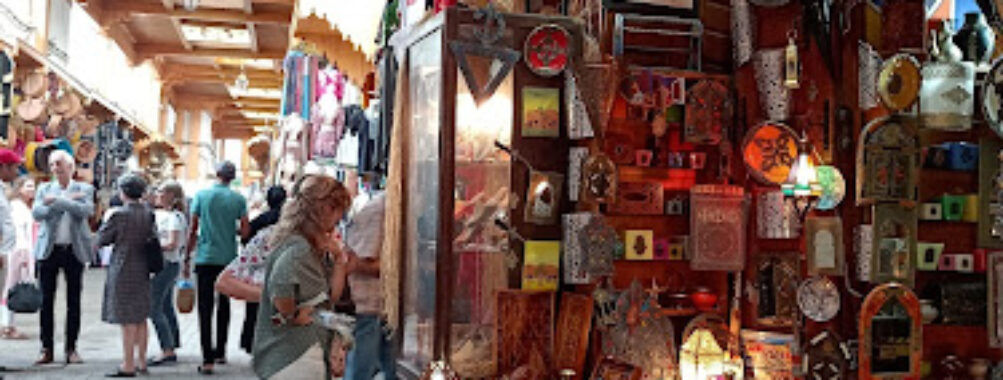
Rabat Old Market
Table of Contents
Description
Let me tell you about one of my favorite spots in Morocco’s capital – the Rabat Old Market (Souk). I spent countless hours exploring its winding alleyways during my travels, and honestly, it’s an absolute feast for the senses. The market sprawls through the heart of the medina, where centuries of trading history come alive in the most fascinating way.
The moment you step into this traditional marketplace, you’re greeted by the unmistakable aroma of fresh spices mingling with the scent of leather goods and handwoven textiles. Local artisans, whose families have practiced their crafts for generations, work diligently in their small workshops, creating everything from intricate metalwork to colorful ceramics.
What really makes this place special is how it maintains its authentic character while still catering to both locals and tourists. You’ll see Moroccan families haggling over fresh produce right alongside visitors examining handmade jewelry or traditional carpets. And ya know what? The atmosphere here is just different from other markets I’ve visited – there’s this wonderful mix of chaos and charm that’s totally unique to Rabat.
Key Features
• Traditional Moroccan handicrafts section featuring handmade leather goods, pottery, and metalwork
• Fresh produce area with local fruits, vegetables, and aromatic spices
• Artisan workshops where you can watch craftspeople at work
• Textile section filled with handwoven carpets, blankets, and traditional clothing
• Local food stalls serving authentic Moroccan street food and sweets
• Antique dealers offering unique collectibles and vintage items
• Jewelry quarter specializing in silver and traditional Berber designs
• Spice merchants displaying colorful mounds of exotic seasonings
• Traditional beauty products section with natural soaps and argan oil
• Small cafes perfect for mint tea breaks between shopping
Best Time to Visit
From my experience, timing your visit right can make a huge difference. Early mornings (around 8-10 AM) are perfect if you wanna avoid the crowds and catch the market coming to life. The vendors are setting up their displays, and the atmosphere is more relaxed – plus, you’ll get better prices!
The market really gets going between October and April when the weather’s more pleasant. Summer months can be pretty intense with the heat, especially during midday. If you do visit during summer, try to go either early morning or late afternoon.
Fridays are typically quieter before afternoon prayers, while weekends tend to get pretty packed with both locals and tourists. And hey, avoid visiting during major religious holidays like Ramadan or Eid, as many shops might be closed or operating on different schedules.
How to Get There
Getting to the Old Market is pretty straightforward, tho it took me a couple tries to figure out the best route my first time! The market sits in the medina, and you can reach it several ways. Grab a blue petit taxi from anywhere in Rabat – they’re cheap and plentiful. Just make sure they turn on the meter!
If you’re feeling adventurous like I was, take the modern tram to Bab El Had station and walk about 5 minutes to the market entrance. The tram’s super clean and affordable, plus you get to see bits of the city along the way.
For those staying near the medina, it’s totally walkable. Just follow the flow of people heading toward the market – trust me, you can’t miss it! And don’t worry about getting lost; the locals are usually happy to point you in the right direction.
Tips for Visiting
Alright, let me share some hard-earned wisdom from my visits! First off, bargaining is expected – I usually start at about half the initial price and work my way up. But remember to keep it friendly and fun – it’s part of the experience!
Bring cash, and keep it in different pockets. Most vendors don’t accept cards, and it’s smart to have smaller bills for easier transactions. I learned this the hard way when trying to buy a beautiful carpet with too large a bill!
Dress modestly outta respect for local culture. I usually wear lightweight, loose-fitting clothes that cover shoulders and knees. Comfy walking shoes are a must – those cobblestone alleys can be tricky!
Take photos respectfully – always ask permission before snapping pics of people or their goods. Some vendors might expect a small purchase in return for photos.
Watch your belongings in crowded areas, just like you would in any busy market worldwide. I use a cross-body bag that stays close to me.
Consider hiring a local guide for your first visit. They know the best spots and can help with bargaining. Plus, they’ll share fascinating stories about the market’s history that you won’t find in guidebooks.
Take breaks when needed – the sensory experience can be overwhelming! Pop into one of the small cafes for mint tea and people-watching. It’s actually one of my favorite parts of visiting the market.
And lastly, don’t feel pressured to buy immediately. Take your time, compare prices at different stalls, and only purchase what you truly love. The best finds usually happen when you’re not actively looking for them!
Location
Places to Stay Near Rabat Old Market
Find and Book a Tour
Explore More Travel Guides
No reviews found! Be the first to review!